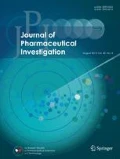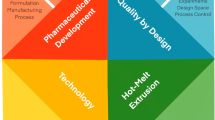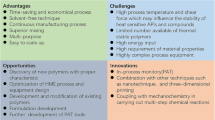Abstract
Hot Melt Extrusion (HME) technology is a widely used for manufacturing process in the plastic and pharmaceutical industries and is an efficient and simple for the production of a solid dispersion. This technique is an environmental friendly, continuous process that does not use solvents. It is time and cost efficient and can be easily scaled up. In addition, HME may be used in conjunction with other technologies to effectively increase the solubility and dissolution rate of poorly water-soluble drugs. Numerous research papers on the progress of HME technology in the pharmaceutical industry have been written, and products manufactured using HME have been approved by the FDA. However, there are some drawbacks to the products manufactured using through HME. These are related to the high energy input coming from the applied shear forces and high temperature, which could lead to drug or polymer degradation and thus significantly impact the product quality. Despite these disadvantages, HME has been employed in various advanced applications, such as taste masking and targeted drug delivery. This review article focuses on advances in HME technology, which include improvement in the weaknesses of HME, patient-centric formulations, and the outlook for uses such as formulation development.


(Reprinted with permission from Vynckier et al. 2015. Copyrightⓒ 2015 Elsevier Ltd)

(Reprinted with permission from Pietrzak et al. 2015. Copyrightⓒ 2015 Elsevier Ltd)

(Reprinted with permission from Patil et al. 2015. Copyrightⓒ 2015 The Springer Ltd)
Similar content being viewed by others
References
Alshehri SM, Tiwari RV, Alsulays BB, Ashour EA, Alshetaili AS, Almutairy B, Park J-B, Morott J, Sandhu B, Majumdar S (2016) Investigation of the combined effect of MgO and PEG on the release profile of mefenamic acid prepared via hot-melt extrusion techniques. Pharmaceutical Dev Technol 1–14 (online)
Ashour A, Kulkarni E, Almutairy V, Park J-B, Shah SP, Majumdar S, Lian Z, Pinto E, Bi V, Durig T (2016) Influence of pressurized carbon dioxide on ketoprofen-incorporated hot-melt extruded low molecular weight hydroxypropylcellulose. Drug Dev Ind Pharm 42:123–130
Breitenbach J, Magerlein M (2003) Melt-extruded molecular dispersions. Drugs Pharm Sci 133:245–260.
Buanz AB, Saunders MH, Basit AW, Gaisford S (2011) Preparation of personalized-dose salbutamol sulphate oral films with thermal ink-jet printing. Pharm Res 28:2386–2392
Chandra Sekhara Rao G, Satish Kumar M, Mathivanan N, Bhanoji Rao M (2004) Nanosuspensions as the most promising approach in nanoparticulate drug delivery systems. Die Pharmazie 59:5–9
Chiou J, Barlow JW, Paul D (1985) Plasticization of glassy polymers by CO2. J Appl Polym Sci 30:2633–2642
Crowley MM, Zhang F, Koleng JJ, McGinity JW (2002) Stability of polyethylene oxide in matrix tablets prepared by hot-melt extrusion. Biomaterials 23:4241–4248
Crowley MM, Fredersdorf A, Schroeder B, Kucera S, Prodduturi S, Repka MA, McGinity JW (2004) The influence of guaifenesin and ketoprofen on the properties of hot-melt extruded polyethylene oxide films. Eur J Pharm Sci 22:409–418
Crowley MM, Zhang F, Repka MA, Thumma S, Upadhye SB, Kumar Battu S, McGinity JW, Martin C (2007) Pharmaceutical applications of hot-melt extrusion: part I. Drug Dev Ind Pharm 33:909–926
Desai PM, Vaerenbergh GV, Holman J, Liew CV, Heng PWS (2015) Continuous manufacturing: the future in pharmaceutical solid dosage form manufacturing. Pharm Bioprocess 3:357–360
Dhenge RM, Fyles RS, Cartwright JJ, Doughty DG, Hounslow MJ, Salman AD (2010) Twin screw wet granulation: granule properties. Chem Eng J 164:322–329
Dierickx L, Saerens L, Almeida A, De Beer T, Remon JP, Vervaet, C (2012) Co-extrusion as manufacturing technique for fixed-dose combination mini-matrices. Eur J Pharm Biopharm 81:683–689
Dvořáčková K, Doležel P, Mašková E, Muselík J, Kejdušová M, Vetchý D (2013) The effect of acid pH modifiers on the release characteristics of weakly basic drug from hydrophlilic–lipophilic matrices. AAPS PharmSciTech 14:1341–1348
El Hagrasy A, Hennenkamp J, Burke M, Cartwright J, Litster J (2013) Twin screw wet granulation: influence of formulation parameters on granule properties and growth behavior. Powder Technol 238:108–115
Elkovitch MD, Tomasko DL (2000) Effect of supercritical carbon dioxide on morphology development during polymer blending. Polym Eng Sci 40:1850–1861
Follonier N, Doelker E, Cole ET (1994) Evaluation of hot-melt extrusion as a new technique for the production of polymer-based pellets for sustained release capsules containing high loadings of freely soluble drugs. Drug Dev Ind Pharm 20:1323–1339
Follonier N, Doelker E, Cole ET (1995) Various ways of modulating the release of diltiazem hydrochloride from hot-melt extruded sustained release pellets prepared using polymeric materials. J Controlled Release 36:243–250
Fule R, Meer T, Sav A, Amin P (2013) Solubility and dissolution rate enhancement of lumefantrine using hot melt extrusion technology with physicochemical characterisation. J Pharm Investig 43:305–321
Fule R, Meer T, Amin P, Dhamecha D, Ghadlinge S (2014) Preparation and characterisation of lornoxicam solid dispersion systems using hot melt extrusion technique. J Pharm Investig 44:41–59
Giles H, Wagner J, Mount E (2005) Extrusion: the definitive processing guide and handbook. Norwich: William Andrew. Inc
Giordano RA, Wu BM, Borland SW, Cima LG, Sachs EM, Cima MJ (1997) Mechanical properties of dense polylactic acid structures fabricated by three dimensional printing. J Biomater Sci Polym Ed 8:63–75
Hanafy A, Spahn-Langguth H, Vergnault G, Grenier P, Grozdanis MT, Lenhardt T, Langguth P (2007) Pharmacokinetic evaluation of oral fenofibrate nanosuspensions and SLN in comparison to conventional suspensions of micronized drug. Adv Drug Deliv Rev 59:419–426
Jaiswar DR, Pawar JN, Amin PD (2015) Hot melt extrusion: continuous process of preparation of sustained released matrix tablet by using hydroxypropylcellulose. Am J PharmTech Res 6:295–312
Jaiswar DR, Jha D, Amin PD (2016) Preparation and characterizations of stable amorphous solid solution of azithromycin by hot melt extrusion. J Pharm Investig 46:655–668
Javeer SD, Patole R, Amin P (2013) Enhanced solubility and dissolution of simvastatin by HPMC-based solid dispersions prepared by hot melt extrusion and spray-drying method. J Pharm Investig 43:471–480
Joe JH, Lee WM, Park Y-J, Joe KH, Oh DH, Seo YG, Woo JS, Yong CS, Choi H-G (2010) Effect of the solid-dispersion method on the solubility and crystalline property of tacrolimus. Int J Pharm 395:161–166
Kawabata Y, Yamamoto K, Debari K, Onoue S, Yamada S (2010) Novel crystalline solid dispersion of tranilast with high photostability and improved oral bioavailability. Eur J Pharm Sci 39:256–262
Kumar CS (2010) Nanotechnology tools in pharmaceutical R&D. Mater Today 12:24–30
Kumar A, Gernaey KV, De Beer T, Nopens I (2013) Model-based analysis of high shear wet granulation from batch to continuous processes in pharmaceutical production–a critical review. Eur J Pharm Biopharm 85:814–832
Lodaya M, Mollan M, Ghebre-Sellassie I (2003) Twin-screw wet granulation. Drug Pharm Sci 133:323–344
Maniruzzaman M, Boateng JS, Snowden MJ, Douroumis D (2012) A review of hot-melt extrusion: process technology to pharmaceutical products. ISRN Pharm 2012:1–10
Maniruzzaman M, Boateng JS, Chowdhry BZ, Snowden MJ, Douroumis D (2014) A review on the taste masking of bitter APIs: hot-melt extrusion (HME) evaluation. Drug Dev Ind Pharm 40:145–156
Markarian J (2014) Optimizing solid dosage manufacturing. Pharm Technol 38:24
McGinity JW, Zhang F (2003) Melt-extruded controlled-release dosage forms. Drugs Pharm Sci 133:183–208
McGinity JW, Zhang F, Koleng J, Repka M (2001) Hot-melt extrusion as a pharmaceutical process. Am Pharm Rev 4:25–37
Medina-Gonzalez Y, Camy S, Condoret J-S (2012) Cellulosic materials as biopolymers and supercritical CO2 as a green process: chemistry and applications. Int J Sustainable Eng 5:47–65
Mehuys E, Vervaet C, Remon JP (2004) Hot-melt extruded ethylcellulose cylinders containing a HPMC–Gelucire® core for sustained drug delivery. J Controll Release 94:273–280
Moon C, Oh E (2016) Rationale and strategies for formulation development of oral fixed dose combination drug products. J Pharm Investig 46:615–631
Mueannoom W, Srisongphan A, Taylor KM, Hauschild S, Gaisford S (2012) Thermal ink-jet spray freeze-drying for preparation of excipient-free salbutamol sulphate for inhalation. Eur J Pharm Biopharm 80:149–155
Park J-B, Kang C-Y, Kang W-S, Choi H-G, Han H-K, Lee B-J (2013) New investigation of distribution imaging and content uniformity of very low dose drugs using hot-melt extrusion method. Int J Pharm 458:245–253
Patil H, Kulkarni V, Majumdar S, Repka MA (2014) Continuous manufacturing of solid lipid nanoparticles by hot melt extrusion. Int J Pharm 471:153–156
Patil H, Feng X, Ye X, Majumdar S, Repka MA (2015) Continuous production of fenofibrate solid lipid nanoparticles by hot-melt extrusion technology: a systematic study based on a quality by design approach. AAPS J 17:194–205
Patil H, Tiwari RV, Repka MA (2016) Hot-melt extrusion: from theory to application in pharmaceutical formulation. AAPS PharmSciTech 17:20–42
Pietrzak K, Isreb A, Alhnan MA (2015) A flexible-dose dispenser for immediate and extended release 3D printed tablets. Eur J Pharm Biopharm 96:380–387
Rizvi S, Mulvaney S, Sokhey A (1995) The combined application of supercritical fluid and extrusion technology. Trends Food Sci Technol 6, 232–240.
Rosenzweig DH, Carelli E, Steffen T, Jarzem P, Haglund L (2015) 3D-printed ABS and PLA scaffolds for cartilage and nucleus pulposus tissue regeneration. Int J Mol Sci 16:15118–15135
Saerens L, Dierickx L, Lenain B, Vervaet C, Remon JP, De Beer, T (2011) Raman spectroscopy for the in-line polymer–drug quantification and solid state characterization during a pharmaceutical hot-melt extrusion process. Eur J Pharm Biopharm 77:158–163
Scoutaris N, Alexander MR, Gellert PR, Roberts CJ (2011) Inkjet printing as a novel medicine formulation technique. J Controll Release 156:179–185
Scoutaris N, Hook AL, Gellert PR, Roberts CJ, Alexander MR, Scurr DJ (2012) ToF-SIMS analysis of chemical heterogenities in inkjet micro-array printed drug/polymer formulations. J Mater Sci 23:385–391
Sharma G, Mueannoom W, Buanz AB, Taylor KM, Gaisford S (2013) In vitro characterisation of terbutaline sulphate particles prepared by thermal ink-jet spray freeze drying. Int J Pharm 447:165–170
Shim S-Y, Ji C-W, Sah H, Park E-S, Lee B-J (2006) Characterization of itraconazole semisolid dosage forms prepared by hot melt technique. Arch Pharm Res 29:1055–1060
Siepe S, Herrmann W, Borchert H-H, Lueckel B, Kramer A, Ries A, Gurny R (2006) Microenvironmental pH and microviscosity inside pH-controlled matrix tablets: an EPR imaging study. J Controll Release 112:72–78
Sprockel OL, Sen M, Shivanand P, Prapaitrakul W (1997) A melt-extrusion process for manufacturing matrix drug delivery systems. Int J Pharm 155:191–199
Subramaniam B, Rajewski RA, Snavely K (1997) Pharmaceutical processing with supercritical carbon dioxide. J Pharm Sci 86:885–890
Thompson M, Sun J (2010) Wet granulation in a twin-screw extruder: implications of screw design. J Pharm Sci 99:2090–2103
Tiwari RV, Patil H, Repka MA (2016) Contribution of hot-melt extrusion technology to advance drug delivery in the 21st century. Expert Opin Drug Deliv 13:451–464
Tran TT-D, Tran PH-L, Choi H-G, Han H-K, Lee B-J (2010) The roles of acidifiers in solid dispersions and physical mixtures. Int J Pharm 384:60–66
Ventola CL (2014) Medical applications for 3D printing: current and projected uses. Pharm Ther 39:704
Vercruysse J, Díaz DC, Peeters E, Fonteyne M, Delaet U, Van Assche I, De Beer T, Remon JP, Vervaet, C (2012) Continuous twin screw granulation: influence of process variables on granule and tablet quality. Eur J Pharm Biopharm 82:205–211
Vercruysse J, Delaet U, Van Assche I, Cappuyns P, Arata F, Caporicci G, De Beer T, Remon JP, Vervaet, C (2013) Stability and repeatability of a continuous twin screw granulation and drying system. Eur J Pharm Biopharm 85:1031–1038
Verhoeven E, De Beer T, Van den Mooter G, Remon JP, Vervaet, C (2008) Influence of formulation and process parameters on the release characteristics of ethylcellulose sustained-release mini-matrices produced by hot-melt extrusion. Eur J Pharm Biopharm 69:312–319
Verreck G, Decorte A, Heymans K, Adriaensen J, Cleeren D, Jacobs A, Liu D, Tomasko D, Arien A, Peeters J (2005) The effect of pressurized carbon dioxide as a temporary plasticizer and foaming agent on the hot stage extrusion process and extrudate properties of solid dispersions of itraconazole with PVP-VA 64. Eur J Pharm Sci 26:349–358
Vervaet C, Remon JP (2005) Continuous granulation in the pharmaceutical industry. Chem Eng Sci 60:3949–3957
Vynckier AK, Dierickx L, Voorspoels J, Gonnissen Y, Remon JP, Vervaet C (2014) Hot-melt co-extrusion: requirements, challenges and opportunities for pharmaceutical applications. J Pharm Pharmacol 66:167–179
Wu C, Luo Y, Cuniberti G, Xiao Y, Gelinsky M (2011) Three-dimensional printing of hierarchical and tough mesoporous bioactive glass scaffolds with a controllable pore architecture, excellent mechanical strength and mineralization ability. Acta Biomater 7:2644–2650
Yang M, He S, Fan Y, Wang Y, Ge Z, Shan L, Gong W, Huang X, Tong Y, Gao C (2014) Microenvironmental pH-modified solid dispersions to enhance the dissolution and bioavailability of poorly water-soluble weakly basic GT0918, a developing anti-prostate cancer drug: preparation, characterization and evaluation in vivo. Int J Pharm 475:97–109
Young CR, Koleng JJ, McGinity JW (2002) Production of spherical pellets by a hot-melt extrusion and spheronization process. Int J Pharm 242:87–92
Zhang F (1999) Hot-melt extrusion as a novel technology to prepare sustained-release dosage forms. University of Texas, Austin
Zhang F, McGinity JW (2000) Properties of hot-melt extruded theophylline tablets containing poly (vinyl acetate). Drug Dev Ind Pharm 26:931–942
Acknowledgements
This paper was supported by Bumsuk Academic Research Fund in 2016.
Author information
Authors and Affiliations
Corresponding author
Ethics declarations
Conflict of interest
The authors declare that they have no conflict of interest.
Rights and permissions
About this article
Cite this article
Hwang, I., Kang, CY. & Park, JB. Advances in hot-melt extrusion technology toward pharmaceutical objectives. Journal of Pharmaceutical Investigation 47, 123–132 (2017). https://doi.org/10.1007/s40005-017-0309-9
Received:
Accepted:
Published:
Issue Date:
DOI: https://doi.org/10.1007/s40005-017-0309-9




